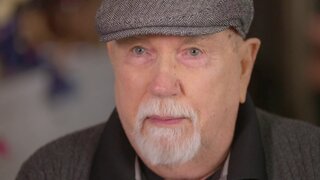Create a free profile to get unlimited access to exclusive videos, breaking news, sweepstakes, and more!
Kelly Siegler Tackles Black Friday Rampage After Three Stabbed in Houston Wig Shop
Prosecutors initially struggled to glean why 20-year-old Dror Goldberg viciously attacked three people in a Houston wig shop.
Kelly Siegler revisits a Houston, Texas, shop where three people were brutally stabbed in 1998 in an all-new episode of Prosecuting Evil with Kelly Siegler.
The day after Thanksgiving was Friday, November 27, 1998, and at around 4:00 p.m., eyewitness Dr. Randall Beckman was on his way to buy dog food at a shopping center in the West University neighborhood of southwest Houston. He immediately found it odd seeing a young male in his late teens or early 20s making a mad dash from the Wigs by Andre wig shop to a Lincoln Navigator in the parking lot.
Inside the family-owned-and-operated shop, someone had fatally slashed the throat of Manuela “Manny” Silverio and stabbed the store’s owners, married couple Roberta and Roland Ingrando.
Roberta said she’d just decided to close the shop early when an unknown man “barged in,” first attacking Silverio in a frenzy. Roberta said she offered the stranger money, but the attacker was uninterested in stealing anything and resorted to bloodshed.
“It was just something out of a horror movie,” Roberta told Prosecuting Evil, airing Saturdays at 8/7c on Oxygen. “I couldn’t believe this happened to us.”
RELATED: Revisiting Prosecuting Evil's Kelly Siegler's Career in the Court
The Wig Shop Murder
Roberta was stabbed 14 times, while Roland Ingrando, who ran from his office after hearing Silverio’s “death scream,” was stabbed twice before the assailant took off on foot.
Silverio’s daughters, Yvette Menendez and Yvonne Palmer, said that earlier that day, they’d spoken to their mother at the shop just before she had to go and see about the store’s final customer.
“That was the devil that came in,” Palmer told Prosecuting Evil.
After glancing at the suspect and writing down the young man’s license plate number, Dr. Beckman entered the wig shop and found a bloody scene. His attempts to resuscitate Silverio were unsuccessful.
“There was blood everywhere,” said Sergeant Mike Peters of the Houston Police Department’s Homicide Division. “Bloody curlers, blood on the phone that was used to call the police, wigs all over the place.”
A Look Into Dror Goldberg
Siegler referred to Dr. Beckman as the “witness from Heaven” for trusting his instincts and gleaning as much information about the suspect as possible. Siegler called it the “jackpot” when he provided the suspect’s license plate number, registered to an address about three miles away on Dunstan Street.
Officers with the Houston Police Department visited the home. They found the Lincoln Navigator in the driveway, which was “warm to the touch,” according to Sergeant Larry Ware. However, when they knocked on the door, a maid said the homeowner was away on vacation.
They soon spotted 20-year-old Dror Goldberg in the driveway, matching the description of the person observed running away from the wig shop shortly after 4:00 p.m. He told officers he was the homeowner’s son but lived in an apartment just three blocks from the wig store.
Since Goldberg couldn’t consent to a search of the Lincoln because it belonged to his father, police looked through his personal Ford pickup truck, finding a double-edged knife inside.
According to Kelly Siegler, it wasn’t enough for an arrest.
RELATED: "Courtroom Theater" Helps Texas Prosecutor Convict "Blue-Eyed Butcher" Susan Wright
“This is Texas; everybody’s got a knife,” she told Prosecuting Evil. “I got a knife in my purse.”
Goldberg gave a statement to police but denied ever going to Wigs by Andre. Dr. Beckman, however, successfully picked his face from a photograph lineup. Meanwhile, the Ingrandos, hospitalized from their knife injuries, were unable to make a positive identification at the time.
Roland Ingrando said he lost his glasses during the attack, rendering him unable to get a good look at the suspect. But Roberta — then recovering from puncture wounds to the heart, lungs, and intestine — eventually picked Goldberg out from a video lineup.
Recollecting the crime at the shop 25 years later with Siegler, Roberta explained how the killer cut her wrist after she reached her phone.
“He just whispered in my ear, he said, ‘Oh no, now I’m going to cut your nose. I’m going to cut your ear. I’m going to make you pretty,’” Roberta told Siegler, pointing to where the attacker made nicks around her neck and face area.
When investigators finally got their warrant to search the Lincoln, they found wig fibers inside.
“The circumstantial evidence case against Dror Goldberg is building,” Siegler told Prosecuting Evil. “We don’t have any D.N.A. evidence, and we don’t have a motive, but those are not required in order to get an indictment for murder.”
The search for a suspected killer and loved ones’ resolve
Dror Goldberg was indicted for murder in March 1999, several months after the Black Friday attack, but when authorities went to arrest him, he was nowhere to be found.
Meanwhile, Manny Silverio’s loved ones, including daughters Yvette Menendez and Yvonne Palmer, worked “day and night” to get Goldberg back to face murder charges. They arranged their own press conferences and invited the media to their events, often handing out flyers with Goldberg’s photo and information.
Soon, Goldberg — whose whereabouts were still unknown — was slapped with federal charges for flight to avoid prosecution.
“My mother was not going to be just a number,” Menendez told Prosecuting Evil. “We wanted to go out there and find answers.”
Siegler called the women “a textbook example of what all families should do” when dealing with an unsolved murder.
Four months later, in July 1999, a keen-eyed officer at Germany’s Frankfurt airport found Goldberg “acting funny,” according to Siegler, soon learning he was wanted for murder and prompting his arrest and extradition.
By then, Goldberg had retained famed Texas criminal defense attorney Dick DeGuerin, whose high-profile clientele included convicted murderer Robert Durst and cult leader David Koresh. DeGuerin had more experience than Siegler and whom Siegler cited as “the best.”
“He had a formidable reputation, and he would do anything to win,” Siegler admitted. “When he walks in the courtroom, he commands the courtroom.”
Backed by DeGuerin, Goldberg was released on $20,000 bail, making Silverio’s daughters “livid.” But one evening, Siegler was pulling a late one at the office when one of Goldberg’s high school friends phoned in, explaining that he had previously received letters from Goldberg that depicted a desire to inflict violence against women.
The letters’ contents shattered the image Goldberg presented as “an All-American boy,” Siegler said.
“The letters were very graphic and very descriptive about the need and the desire to want to hurt somebody,” Siegler continued. Some of the letters included his wishes to rape women and having premonitions about murder.
Siegler presented the judge with the newly surfaced letters, and Goldberg’s bail was revoked.
Dror Goldberg’s murder trial begins
Dror Goldberg’s murder trial began on March 27, 2000, though his new appearance — which consisted of Goldberg gaining 40 pounds, wearing eyeglasses, and having a newly dyed and neat hair-do — “horrified” Silverio’s daughters. According to Siegler, it was all a part of a perceived defense strategy to help keep his client away from a conviction.
“I’d never seen him in trial before, and boy, did I learn a lot,” Siegler said of her legal opponent.
Loved ones said Goldberg’s transformation helped to build doubt among the eyewitnesses, including Dr. Beckman and the surviving victims. For example, during cross-examination, Goldberg's counsel challenged Roberta’s statements about the attacker having sandy hair.
Dr. Beckman, recalling his time on the stand, remembered DeGuerin asking “the same question multiple times,” purportedly an attempt to throw witnesses off from their original statements.
“Oh, my God. Cross-examination is Dick’s best tool and weapon,” Siegler told Prosecuting Evil. “I had no idea exactly why, or how he did it, but I got a first-hand class at why he’s a master at that.”
Eventually, Siegler claimed, she observed DeGuerin enough to learn how to “beat him at his own game.”
Despite DeGuerin’s attempts to cross-examine witnesses “to exhaustion,” according to Siegler, the defense also called in experts to testify about memory in an attempt to discredit Dr. Beckman. DeGuerin also proffered that the wig fibers found in Goldberg’s personal pickup truck were from the defendant’s “sweet, little, old” grandmother visiting the very wig shop days before the murder and riding in the vehicle, said Siegler.
“Grandma was so coached that the minute Kelly asked her one question, [it] threw her off completely,” said Yvonne Palmer. “Kelly is discrediting her completely, but what did jurors believe?”
After all, there was no murder weapon, no D.N.A., and no motive as to why Goldberg could have wanted Silverio and the Ingrandos dead.
“To prove the motive, we had to try and establish that Dror Goldberg did this murder because of a need and a desire to see what it felt like to kill somebody,” Siegler said.
A “window into a sick mind”
Hoping she could speak to Goldberg’s alleged motive, the state called Houston Independent School District Police Officer Susan Pendergrass to the stand. In 1995, while assigned to Bellaire High School, Pendergrass pulled Goldberg over for throwing a beer can from his moving vehicle and brought him into the principal’s office.
There, Pendergrass searched his backpack and came upon some of Goldberg’s disturbing writings, which consisted of an entry titled “How to Kill Women.”
“He says that the urge to kill is getting stronger; doesn’t know if he can fight it,” Pendergrass told Prosecuting Evil. “I’ve never been so disturbed and so emotional over a writing in my life.”
Journal entries included Goldberg describing wanting to make “tiny slits” to a woman’s body while asking the victim, “Do you feel pretty,” which exactly matched Roberta Ingrando’s account of what happened to her that fateful day.
“These journals were certainly a window into a sick mind,” said co-counsel Lester Blizzard of the Harris County District Attorney’s Office.
On April 14, 2000, after 17 hours of jury deliberations, Dror Goldberg, described by Susan Pendergrass as a “cold-blooded, sadistic, evil, torturing killer,” was found guilty of murdering Manuela “Manny” Silverio and sentenced to 48 years in prison.
He became eligible for parole in 2023.
“I’m afraid he’s going to come back and finish the job,” Roberta Ingrando told Siegler while filming Prosecuting Evil.
“He didn’t get the life sentence, but we did,” said Palmer. “And we have to fight for our mom, and we have to do this so justice is served. And he needs to rot in Hell.”
Watch all-new episodes of Prosecuting Evil with Kelly Siegler, airing Saturdays at 8/7c on Oxygen.



































